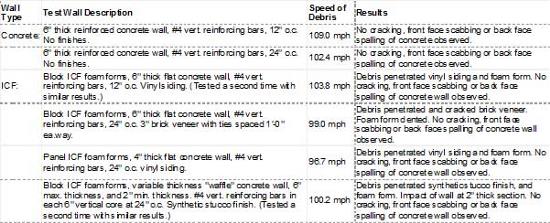Debris driven by high winds presents the greatest hazard to homeowners and their homes during tornadoes and hurricanes. Recent laboratory testing at the Wind Engineering Research Center, Texas Tech University, compared the impact resistance of residential concrete wall construction to conventionally framed walls. The frame walls failed to stop the penetration of airborne hazards. The concrete walls successfully demonstrated the strength and mass to resist the impact of wind driven debris.
What was tested?
Various wall specimens were subjected to the impact of a 2 x 4 wood stud traveling at up to 100 miles per hour. This is equivalent to the weight and speed of debris generated during a tornado with 250 miles per hour winds. This testing covers the maximum wind speed generated in 99 percent of the tornadoes occurring in the United States. Wind speeds are less than 150 miles per hour in 90 percent of tornadoes.
Ten wall specimens were constructed, each representative of the type of construction now used to build frame homes and concrete homes in the U.S. Tables 1 & 2 describe each wall assembly tested.
The Wind Engineering Research Center’s compressed air cannon was used to propel the wood stud debris "missile" at the test walls. The stud was propelled along its axis with the leading end hitting the specimen. Electronic timing devices measured the speed of the debris as it traveled from the cannon to the test walls located 16 feet 6 inches away.
How did the frame walls perform?
The frame walls lacked the weight and mass to resist the impact of the wind driven debris. In each case, the debris traveled completely through the wall assembly with little or no damage to the "missile."

How did the concrete walls perform?
The concrete stopped the debris from traveling through the wall. Exterior finishes were damaged by the impact, but the concrete walls were unscathed. Even the narrowest, 2-inch thick section of "waffle grid" ICF wall was undamaged by the direct impact of the debris at over 100 mph.

Note: All concrete tested: 3,000 PSI compressive strength, maximum aggregate size 3/4 inches, 6 inches slump.
What about damage from hurricanes?
Hurricane wind velocities will be less than the equivalent maximum speeds modeled in these tests. Missile testing designed to mitigate property damage losses from hurricanes use a criterion of a 9-pound missile traveling about 34 miles per hour.
What's the bottom line?
The strength and durability of concrete walls formed with ICFs offer unmatched resistance to the devastation of major storms. Concrete homes are less likely to suffer major damage from debris than conventionally framed houses. This greater measure of built-in safety makes ICF construction the quality choice for your new home.